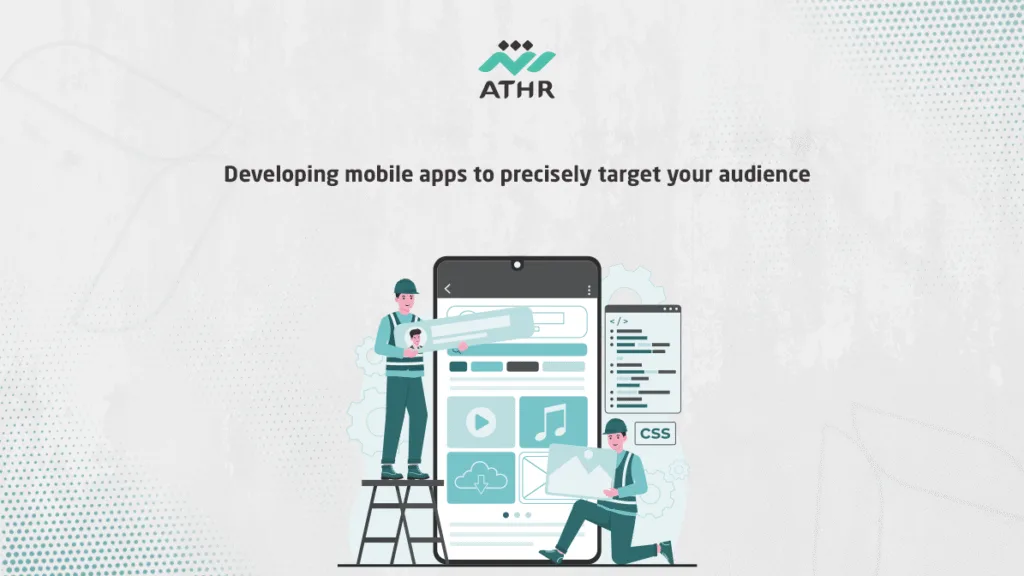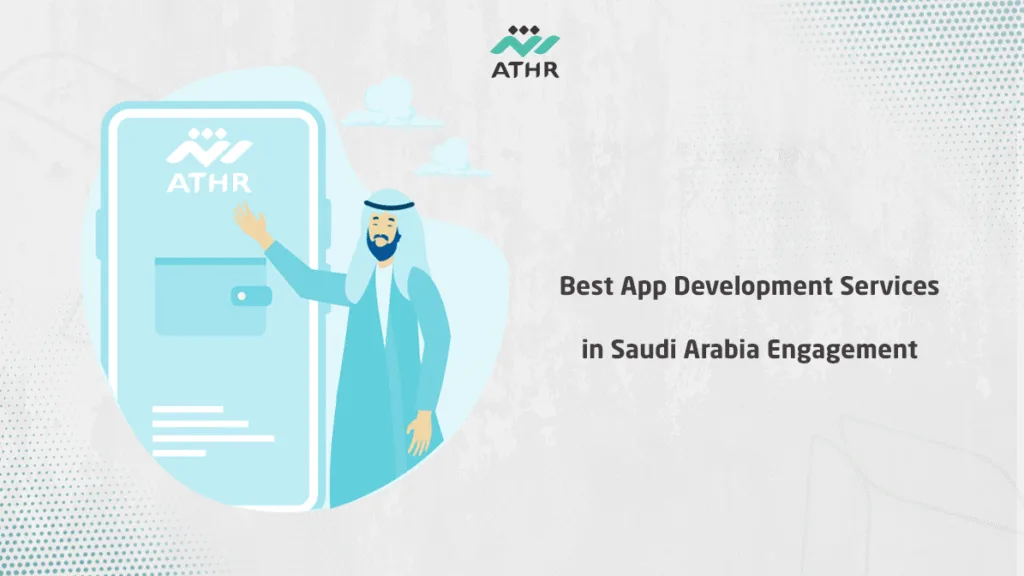Imagine having an app that captures a user’s attention from the very first second, operates at lightning speed, and anticipates their needs before they even ask. This is no longer a fantasy but a reality created by integrating the latest smartphone app development technologies with the expertise of a professional programming team. From AI that personalizes the experience to the best mobile app programming languages that ensure seamless performance and unparalleled security-these are the tools that open the doors to success in a crowded and competitive market.
From design to launch, we are your perfect partner in mobile app development.
جدول المحتوي
- Why Is Smartphone App Development in 2025 Different Than Ever Before?
- The Latest Mobile App Programming Technologies in 2025
- Artificial Intelligence Technologies in Mobile Apps
- The Best Mobile App Programming Languages for Your Next Projects
- Information Security and User Data
- Protection in 2025 Apps
- User Experience (UX) and User Interface (UI) as a Key Success Factor
- How do I ensure my app's success after launch?
- Why should I rely on a specialized company for smartphone app development?
- How much does it cost to develop a mobile app in 2025?
- What are the most important technologies in smartphone app development for 2025?
- How do I start developing a professional mobile app?
- What is the best mobile app development company in 2025?
Why Is Smartphone App Development in 2025 Different Than Ever Before?
The world of smartphone app development is undergoing an unprecedented technological revolution. Competition is no longer about who launches an app first, but who provides an innovative, secure, and fast user experience. This is where Athr Company comes in, helping businesses and developers adopt the latest mobile app programming technologies and smart tools to keep up with increasing user expectations and achieve success in a challenging market.
70% of users abandon apps that do not provide a seamless experience or real value within the first 3 days of use.
Technological Factors That Are Changing the Game
What makes app development different today is the integration of technologies such as:
- Artificial Intelligence (AI) and Machine Learning (ML): To analyze user behavior and deliver personalized content and services.
- Augmented Reality (AR) and Virtual Reality (VR): To create unique interactive experiences, especially in education, shopping, and gaming.
- Latest smart app development tools like Flutter and React Native, which reduce coding time and increase an app’s compatibility across different platforms.
The Impact of User Behavior on App Design and Development
Understanding user behavior has become the cornerstone of smartphone app design and development. Successful apps today are not built on guesswork but on a precise analysis of user needs and preferences-from Browse style and preferred colors and interfaces to how they interact with content. With this data, developers—like the team at Athr Company—can create personalized experiences that increase customer loyalty and maintain continuous engagement with the app.
- Designing simple, user-friendly interfaces that support seamless navigation.
- Optimizing performance and speed to reduce loading time to less than 3 seconds.
- Supporting security and privacy in line with the latest data protection protocols.
📊 A Google study proved that every additional second of delay in app loading can lead to a 20% decrease in conversion rates.
The Latest Mobile App Programming Technologies in 2025

With the rapid evolution of smartphone app development, choosing the right technologies has become a crucial factor in an app’s success. A set of mobile app programming technologies has emerged that helps companies create faster, more secure, and more user-compatible apps.
The Most In-Demand Programming Languages (Swift – Kotlin – Flutter)
- Swift: Apple’s official language for iOS app development, known for its high execution speed and security, in addition to continuous support from the parent company.
- Kotlin: The first choice for Android app development, offering high flexibility and excellent performance while reducing programming errors.
- Flutter: A cross-platform framework from Google that allows for the creation of a single app that runs on both iOS and Android, reducing development time by up to 40%.
Smart App Development Tools to Accelerate Time to Market
In 2025, developers no longer rely solely on manual coding but are taking advantage of the latest smart app development tools such as:
- Firebase: For data storage, user management, and real-time performance analysis.
- Xcode and Android Studio: Integrated Development Environments (IDEs) that provide comprehensive emulators and tests before launch.
- AppGyver and OutSystems: Low-Code/No-Code tools for rapid app development, especially for projects that require a quick pilot launch.
📊 Companies that rely on rapid development tools reduce launch time by up to 50% compared to traditional methods.
Artificial Intelligence Technologies in Mobile Apps
Smartphone app development is no longer limited to traditional programming; artificial intelligence (AI) has become one of the most important drivers redefining how users interact with apps. From performance enhancement to personalized content delivery, integrating AI technologies into mobile apps is a necessity, not a luxury.
How Does AI Improve the User Experience?
AI provides users with a smoother and smarter experience through:
- Behavior Analysis: Tracking app usage patterns to predict user needs.
- Voice Assistants: Such as Siri and Google Assistant, which facilitate command execution via voice commands.
- Dynamic Personalization: Automatically adjusting the interface and content based on user preferences.
Using Machine Learning for Recommendations and Personalized Content
Machine learning is the beating heart of the personalized user experience. Through smart algorithms, an app can:
- Suggest products or services based on purchase or Browse history.
- Display personalized content that suits each user’s interests individually.
- Improve in-app search results to be more accurate and context-aware.
Learn how we can integrate the latest technologies into your app to achieve maximum success.
The Best Mobile App Programming Languages for Your Next Projects
Choosing the right programming language is the step that determines the speed of your app’s development, its performance, and its ease of maintenance in the future. The competition among the best mobile app programming languages has become clearer, with some languages excelling in specific areas like security or performance, while others excel in development ease and multi-platform support.
Criteria for Choosing the Right Language for Your Project
Before starting your project with an app programming company, keep these criteria in mind:
- Target Platform: If your audience is primarily iOS users, Swift is the best choice, while Kotlin is the most suitable for Android.
- Performance Goals: Apps that require high processing, such as games or augmented reality, may need low-level languages or specialized frameworks.
- Time to Market: If the goal is to get to market quickly, using Flutter or React Native can save up to 40% of development time.
- Available Team: Choose a language that your team has experience with to reduce costs and errors.
📌 When planning a cross-platform app, integrating the latest smart app development tools like Flutter with Firebase ensures fast launch and improved performance.
Comparison of Performance, Security, and Ease of Maintenance
| Language / Framework | Performance | Security | Ease of Maintenance | Ideal Use |
| Swift | Very High | High | Medium | Professional iOS apps |
| Kotlin | High | High | High | Modern Android apps |
| Flutter | Very Good | Good | Very High | Cross-platform apps |
| React Native | Good | Good | High | MVP or experimental apps |
| C# with Xamarin | Very Good | High | Medium | Integrated enterprise apps |
Information Security and User Data
Protection in 2025 Apps

In today’s world of smartphone app development, security is no longer an optional extra but a fundamental component that determines whether an app stays in the market or not. With increasing cyber threats, companies need to adopt the best practices in mobile app security to protect user data and maintain trust.
Best Practices in Mobile App Security
To protect user data in 2025, cybersecurity experts recommend following these procedures:
- Data Encryption: Using strong protocols like AES-256 to secure data during transfer and storage.
- Multi-Factor Authentication (MFA): Adding an extra layer of protection through verification via text messages or dedicated apps.
- Permissions Management: Reducing the app’s access to sensitive data unless necessary, with explicit user consent.
- Continuous Security Testing: Conducting regular penetration testing to discover vulnerabilities before they are exploited.
Modern Technologies to Combat Hacks and Cyberattacks
The emergence of the latest smart app development tools includes integrated security technologies, such as:
- AI in Threat Detection: Analyzing unusual behaviors within the app to detect hacking attempts in real time.
- Blockchain for Securing Transactions: Using a distributed ledger to encrypt and distribute data in a way that prevents tampering.
- Advanced Monitoring Tools: Such as Firebase App Check and AWS Shield to monitor and prevent attack attempts.
📱 Get a free consultation from our smartphone app development experts today.
User Experience (UX) and User Interface (UI) as a Key Success Factor
The success of smartphone apps is no longer measured by the number of downloads alone but by user satisfaction and continued use of the app. Here, User Experience (UX) and User Interface (UI) play a pivotal role in achieving this success. Designing a seamless user experience ensures that the user quickly finds what they are looking for, while an attractive interface gives them a sense of professionalism and trust. By adopting the latest UX/UI design standards, Athr Company blends visual appeal with ease of use to deliver apps that give the user an unforgettable experience and drive continuous interaction.
Principles of Designing Attractive and Easy-to-Use Interfaces
To deliver an interface that achieves user satisfaction and increases engagement rates, you must consider:
- Simplicity and Clarity: A design free of complexity, where the user knows what to do the moment they open the app.
- Consistent Colors and Fonts: Using colors that are compatible with the brand identity and improving readability by choosing the right fonts.
- Seamless Navigation: Structuring menus and buttons logically to reduce the number of clicks required to reach a goal.
- Responsive Design: Ensuring the app is displayed perfectly on all screen sizes and devices.
The Importance of Testing and Performance Optimization Before Launch
Even the best designs can fail if they are not adequately tested before launch. The most important steps are:
- Usability Testing: To gather real feedback from users on ease of interaction.
- Load Speed Optimization: Using the latest smart app development tools to compress images and optimize code to open pages in less than 3 seconds.
- Continuous Bug Fixing: Relying on analytics reports to track app performance and quickly address any issues.
The success of smartphone apps no longer depends on the idea alone but on the ability to integrate mobile app programming technologies with the latest smart app development tools, leverage AI technologies in mobile apps, choose the best mobile app programming languages, and provide the highest levels of security and an exceptional user experience.
We have reviewed how each of these technologies can elevate your app, from improving performance and increasing engagement rates to protecting user data and building long-term trust. This is precisely what we offer at Athr Company, where we combine practical expertise, creative vision, and modern technologies to ensure you get an app that meets market expectations and achieves your business goals.




